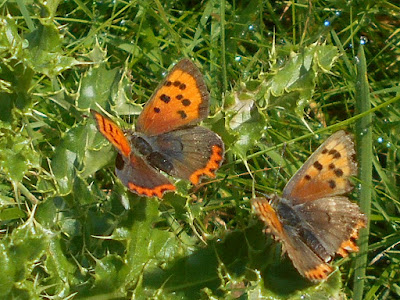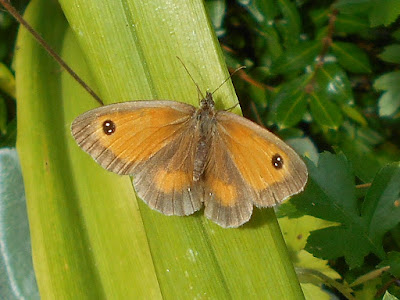 |
Looking north from Newnham Windmill to Daventry.
29 August, 2019
|
According to www.windmillworld.com. it has been converted to an observation tower. If only that were true. In fact, due to vandalism, the only door to this Grade II listed building has been bricked up and no entry is possible.
 |
| The windmill, all points of enttry securely blocked. |
Conditions were fine when I went there earlier today. There was enough breeze to have turned the windmill sails but not enough to be troublesome. Butterflies danced around and a pair of Small Coppers, Lycaena phlaeas, courted on the head of a Creeping Thistle.
 |
Female (left) and male Small Copper butterflies on thistle.
29 August, 2019
|
The female was in good condition, her colours bright; the male was rather tattered but clearly still game. It appears to be a declining species but is still plentiful in some areas, though much varying in numbers from year to year.
Coppers are in the same family, the Lycaenidae, as the blues and a bright male specimen of the Common Blue, Polyommatus icarus, settled in some grasses nearby.
 |
The Common Blue depends on legumes for its larvae.
Windmill Hill, Foxhill Farm. 29 August, 2019
|
My photograph is a considerably improvement on my miserable effort in Byfield Pocket Park just three days ago. Of course, that was a female - women can be difficult!
 |
| The underside of the butterfly is attractively speckled. |
The Common Blue is rather similar to the Holly Blue, Celastrina argiolus, but, as well as differences in colour, the Holly Blue is in flight three or four months earlier in the year.
Apart from the inevitable Speckled Wood a few 'whites' were in the wing. This Small White, Pieris rapae, (formerly Artogeia rapae), posed patiently as I crept forward for a picture. The grass was wet and I had to watch my footing us I made my way down to the lower slopes.
 |
The Small White is decidedly less common than fifty years ago.
Foxhill Farm, 29 August, 2019
|
The photograph clearly shows the raindrops on the grass from the previous night and by now my feet were thoroughly wet. But a pair of buzzards circled overhead, a raven called from a nearby tree and, at the other end of the scale, a wren burst into astonishingly loud song nearby. My cold feet were forgotten.
In truth it wasn't the best of days in terms of flies or spiders but I headed for home, ascending crabwise back up the precipitous slope towards the windmill, well content.










































